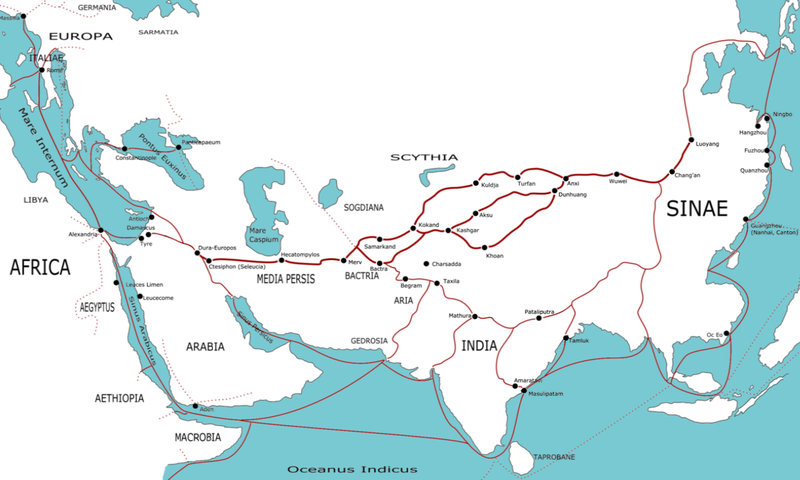Before such an element of cross-cultural contact came about, trade was quite different for the most part. The majority of exchange only consisted of limited networks within a culture. However, through specific instances, bridges and connections developed, creating a vast network of trade, by land and by sea, reaching the corners of the Asian continent. This is known as the Silk Road.
Let us examine what contributed to its development. Basically, the land routes were opened by the Chinese. At the time, China was constantly struggling in conflict with the Xiongnu nomads of Mongolia. The emperor Han Wudi therefore sent an ambassador by the name of Zhang Qian on a mission to find allies to assist in the struggle. Zhang Qian was not entirely successful in his assignment, as he was away for several years, being captured by the Xiongnu on more than one occasion. Nevertheless, his travels brought important knowledge back to the emporer. Zahng Qian realized that there were Chinese products in the far away markets of the West. Han Wudi was very intrigued by this. Around 100 BCE, he basically invaded and pacified a large area of central Asia which allowed direct trade connections to be formed over the land.
The large states of the time supported these routes, building roads, promoting communication, and patrolling the routes. But what kinds of items traveled these connections? From the name, it is clear that Silk very significant. Some cultures used it to wrap their dead in for burial. Others considered it very fine material for important religious occasions. Along with silk, spices were a popular commodity for trade. This included cloves, nutmeg from southeast Asia, and peppers from India. Cotton textiles, pearls, choral, and ivory also came from India. From the West, items such as horses were traded. The Romans sent things like glass, jewelery, pottery, wine, gold, and silver.
The Silk road did not function as you might imagine. What I mean is, people did not literally travel the road with various items to trade. Rather, the items were traded from merchant to merchant, over and over again. This is how they made it over the large area that the routes included. But it was not limited to just goods that were spread throughout the land. Even more impacting, ideas, cultures, and religion traveled it as well. Examples of the this are Christianity and Mahayana Buddhism. Imagine how significant this activity was in the development of the entire world of the day. What kinds of elements of your own life can you relate to this idea? Perhaps your religion? Or even the food you eat?
Subscribe to:
Post Comments (Atom)


No comments:
Post a Comment